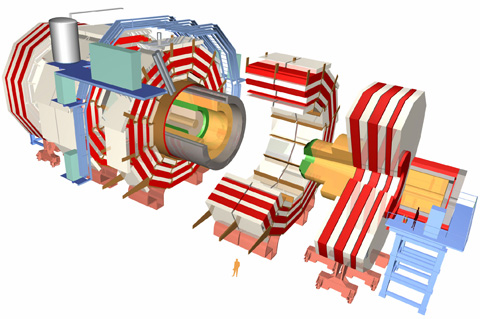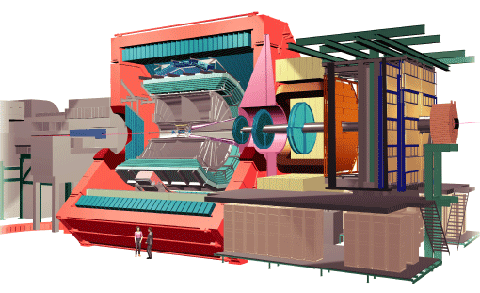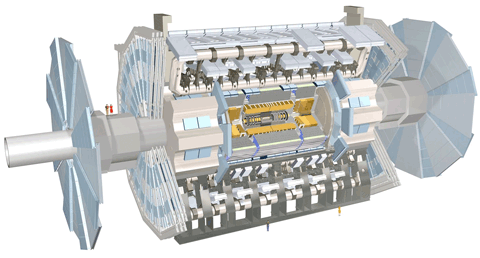Hi My Friends: A VUELO DE UN QUINDE EL BLOG., The Large Hadron Collider (LHC) is a gigantic scientific instrument near
Geneva, where it spans the border between Switzerland and France about
100m underground. It is a particle accelerator
used by physicists to study the smallest known particles – the
fundamental building blocks of all things. It will revolutionise our
understanding, from the minuscule world deep within atoms to the
vastness of the Universe.
CERN-EX-0607007 11 Small Medium Large
Every second the Earth is bombarded by billions of cosmic rays and
occasionally one of these cosmic particles will collide with the Earth's
atmosphere generating a shower of particles known as an 'air shower'.
This is similiar to the collisions and subsequent particle showers
observed in accelerators such as the LHC. Here the CMS detector is
closed so that systems can be tested using muon cosmic rays in the
'Cosmic Challenge'.
Photograph: Claudia Marcelloni
Date: 18 Jul 2006
Keywords: CMS; barrel; yoke; magnet; LHC
Access: DIGITAL
Related links:
CERN Press Release 08/06 : 26 July 2006 (eng)
CERN Press Release 08/06 : 26 juillet 2006 (fre)
Available tirages: 01 02 03 04 05 06 07 08 09 10 11
CMS
Compact Muon Solenoid
The CMS experiment uses a general-purpose detector to investigate a wide range of physics, including the search for the Higgs boson, extra dimensions, and particles that could make up dark matter.
Although it has the same scientific goals as the ATLAS experiment, it
uses different technical solutions and design of its detector magnet
system to achieve these.
The CMS detector is built around a huge solenoid magnet. This
takes the form of a cylindrical coil of superconducting cable that
generates a magnetic field of 4 teslas, about 100 000 times that of the
Earth. The magnetic field is confined by a steel 'yoke' that forms the
bulk of the detector's weight of 12 500 tonnes. An unusual feature of
the CMS detector is that instead of being built in-situ underground,
like the other giant detectors of the LHC experiments, it was
constructed on the surface, before being lowered underground in 15
sections and reassembled.
More than 2000 scientists collaborate in CMS, coming from 155 institutes in 37 countries (October 2006).

CMS detector
- Size: 21 m long, 15 m wide and 15 m high.
- Weight: 12 500 tonnes
- Design: barrel plus end caps
- Location: Cessy, France. See CMS in Google Earth.
Access to the pictures
The ALICE L3 Magnet
Photograph: Saba, A
Date: 01 Apr 2005
Keywords: ALICE; Magnet ALICE L3
Note: ALICE Collection.
ALICE
A Large Ion Collider Experiment
For the ALICE experiment, the LHC will collide lead ions to recreate the conditions just after the Big Bang under laboratory conditions. The data obtained will allow physicists to study a state of matter known as quark‑gluon plasma, which is believed to have existed soon after the Big Bang.All ordinary matter in today’s Universe is made up of atoms. Each atom contains a nucleus composed of protons and neutrons, surrounded by a cloud of electrons. Protons and neutrons are in turn made of quarks which are bound together by other particles called gluons. This incredibly strong bond means that isolated quarks have never been found.
Collisions in the LHC will generate temperatures more than 100,000 times hotter than the heart of the Sun. Physicists hope that under these conditions, the protons and neutrons will "melt", freeing the quarks from their bonds with the gluons. This should create a state of matter called quark-gluon plasma, which probably existed just after the Big Bang when the Universe was still extremely hot. The ALICE collaboration plans to study the quark-gluon plasma as it expands and cools, observing how it progressively gives rise to the particles that constitute the matter of our Universe today.
A collaboration of more than 1000 scientists from 105 physics institutes in 30 countries works on the ALICE experiment (November 2011).

ALICE detector
- Size: 26m long, 16m high, 16m wide
- Weight: 10,000 tonnes
- Design: central barrel plus single-arm-forward muon spectrometer
- Location: St Genis-Pouilly, France. See ALICE in Google Earth.

CERN-EX-0608013 01
Small Medium Large
Scientists are seen working on the inside of the ATLAS cryostat,
which will be used to cool liquid argon to 90 K in the electromagnetic
calorimeter. Thin lead plates immersed in the cooled liquid will
produce electromagnetic showers of particles when an electron, positron
or photon enter the detector. This causes the argon to glow, allowing
the initial particle energy to be measured.
Photograph: Claudia Marcelloni
Date: 22 Aug 2006
Keywords: LHC; ATLAS; SCT; TRT; solenoid; Detector Installation; Magnets; Calorimeters
Access: DIGITAL
Related links:
Photograph: Claudia Marcelloni
Date: 22 Aug 2006
Keywords: LHC; ATLAS; SCT; TRT; solenoid; Detector Installation; Magnets; Calorimeters
Access: DIGITAL
Related links:
ATLAS
ATLAS is one of two general-purpose detectors at the LHC. It will investigate a wide range of physics, including the search for the Higgs boson, extra dimensions, and particles that could make up dark matter. ATLAS will record sets of measurements on the particles created in collisions - their paths, energies, and their identities.
This is accomplished in ATLAS through six different detecting
subsystems that identify particles and measure their momentum and
energy.
Another vital element of ATLAS is the huge magnet system that bends the paths of charged particles for momentum measurement.
The interactions in the ATLAS detectors will create an
enormous dataflow. To digest these data, ATLAS needs a
very advanced trigger and data acquisition system, and a
large computing system.
More than 2900 scientists from 172 institutes in 37 countries work on the ATLAS experiment (December 2009).

ATLAS detector
- Size: 46 m long, 25 m high and 25 m wide. The ATLAS detector is the largest volume particle detector ever constructed.
- Weight: 7000 tonnes
- Design: barrel plus end caps
- Location: Meyrin, Switzerland.

Guillermo Gonzalo Sánchez Achutegui
ayabaca@gmail.com
ayabaca@hotmail.com
ayabaca@yahoo.com
Inscríbete en el Foro del blog y participa : A Vuelo De Un Quinde - El Foro!




No hay comentarios:
Publicar un comentario